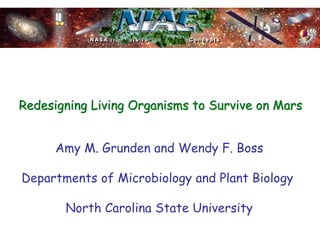The document discusses a project to redesign plants and living organisms to survive on Mars. It describes expressing genes from extremophilic microbes in plants to help them tolerate Martian conditions like low water, low pressure, cold temperatures, and radiation. Initial work involved expressing a heat-stable superoxide reductase gene from Pyrococcus furiosus in tobacco plant cells. Undergraduate students were also engaged in designing virtual plants that could survive on Mars by considering the environmental challenges. The goals were to produce an extremophilic protein in plants and involve students in designing plants for Mars.



























